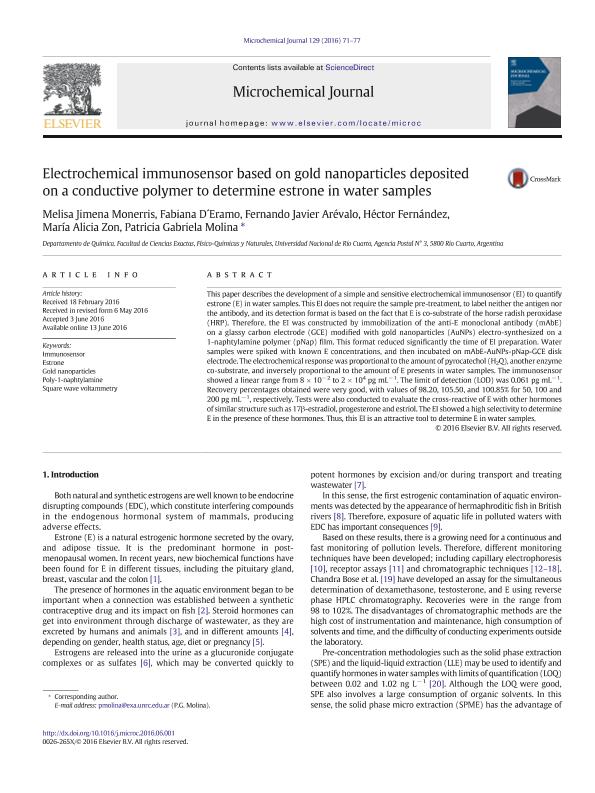Mostrar el registro sencillo del ítem
dc.contributor.author
Monerris, Melisa Jimena

dc.contributor.author
D'eramo, Fabiana

dc.contributor.author
Arevalo, Fernando Javier

dc.contributor.author
Fernandez Alvarez, Hector

dc.contributor.author
Zon, María Alicia

dc.contributor.author
Molina, Patricia Gabriela

dc.date.available
2018-09-12T14:36:54Z
dc.date.issued
2016-06
dc.identifier.citation
Monerris, Melisa Jimena; D'eramo, Fabiana; Arevalo, Fernando Javier; Fernandez Alvarez, Hector; Zon, María Alicia; et al.; Electrochemical immunosensor based on gold nanoparticles deposited on a conductive polymer to determine estrone in water samples; Elsevier Science; Microchemical Journal; 129; 6-2016; 71-77
dc.identifier.issn
0026-265X
dc.identifier.uri
http://hdl.handle.net/11336/59270
dc.description.abstract
This paper describes the development of a simple and sensitive electrochemical immunosensor (EI) to quantify estrone (E) in water samples. This EI does not require the sample pre-treatment, to label neither the antigen nor the antibody, and its detection format is based on the fact that E is co-substrate of the horse radish peroxidase (HRP). Therefore, the EI was constructed by immobilization of the anti-E monoclonal antibody (mAbE) on a glassy carbon electrode (GCE) modified with gold nanoparticles (AuNPs) electro-synthesized on a 1-naphtylamine polymer (pNap) film. This format reduced significantly the time of EI preparation. Water samples were spiked with known E concentrations, and then incubated on mAbE-AuNPs-pNap-GCE disk electrode. The electrochemical response was proportional to the amount of pyrocatechol (H2Q), another enzyme co-substrate, and inversely proportional to the amount of E presents in water samples. The immunosensor showed a linear range from 8 × 10− 2 to 2 × 104 pg mL− 1. The limit of detection (LOD) was 0.061 pg mL− 1. Recovery percentages obtained were very good, with values of 98.20, 105.50, and 100.85% for 50, 100 and 200 pg mL− 1, respectively. Tests were also conducted to evaluate the cross-reactive of E with other hormones of similar structure such as 17β-estradiol, progesterone and estriol. The EI showed a high selectivity to determine E in the presence of these hormones. Thus, this EI is an attractive tool to determine E in water samples.
dc.format
application/pdf
dc.language.iso
eng
dc.publisher
Elsevier Science

dc.rights
info:eu-repo/semantics/openAccess
dc.rights.uri
https://creativecommons.org/licenses/by-nc-sa/2.5/ar/
dc.subject
Estrone
dc.subject
Gold Nanoparticles
dc.subject
Immunosensor
dc.subject
Poly-1-Naphtylamine
dc.subject
Square Wave Voltammetry
dc.subject.classification
Otras Ciencias Químicas

dc.subject.classification
Ciencias Químicas

dc.subject.classification
CIENCIAS NATURALES Y EXACTAS

dc.title
Electrochemical immunosensor based on gold nanoparticles deposited on a conductive polymer to determine estrone in water samples
dc.type
info:eu-repo/semantics/article
dc.type
info:ar-repo/semantics/artículo
dc.type
info:eu-repo/semantics/publishedVersion
dc.date.updated
2018-08-15T13:58:19Z
dc.journal.volume
129
dc.journal.pagination
71-77
dc.journal.pais
Países Bajos

dc.journal.ciudad
Amsterdam
dc.description.fil
Fil: Monerris, Melisa Jimena. Universidad Nacional de Río Cuarto. Facultad de Ciencias Exactas Fisicoquímicas y Naturales. Departamento de Química; Argentina
dc.description.fil
Fil: D'eramo, Fabiana. Universidad Nacional de Río Cuarto. Facultad de Ciencias Exactas Fisicoquímicas y Naturales. Departamento de Química; Argentina
dc.description.fil
Fil: Arevalo, Fernando Javier. Universidad Nacional de Río Cuarto. Facultad de Ciencias Exactas Fisicoquímicas y Naturales. Departamento de Química; Argentina
dc.description.fil
Fil: Fernandez Alvarez, Hector. Universidad Nacional de Río Cuarto. Facultad de Ciencias Exactas Fisicoquímicas y Naturales. Departamento de Química; Argentina
dc.description.fil
Fil: Zon, María Alicia. Universidad Nacional de Río Cuarto. Facultad de Ciencias Exactas Fisicoquímicas y Naturales. Departamento de Química; Argentina
dc.description.fil
Fil: Molina, Patricia Gabriela. Universidad Nacional de Río Cuarto. Facultad de Ciencias Exactas Fisicoquímicas y Naturales. Departamento de Química; Argentina
dc.journal.title
Microchemical Journal

dc.relation.alternativeid
info:eu-repo/semantics/altIdentifier/url/https://www.sciencedirect.com/science/article/pii/S0026265X16300728
dc.relation.alternativeid
info:eu-repo/semantics/altIdentifier/doi/https://doi.org/10.1016/j.microc.2016.06.001
Archivos asociados
